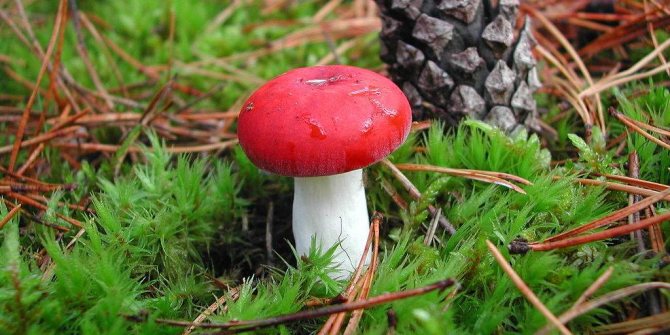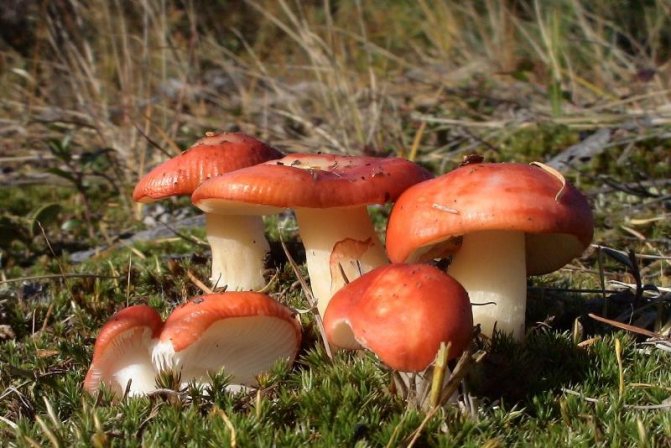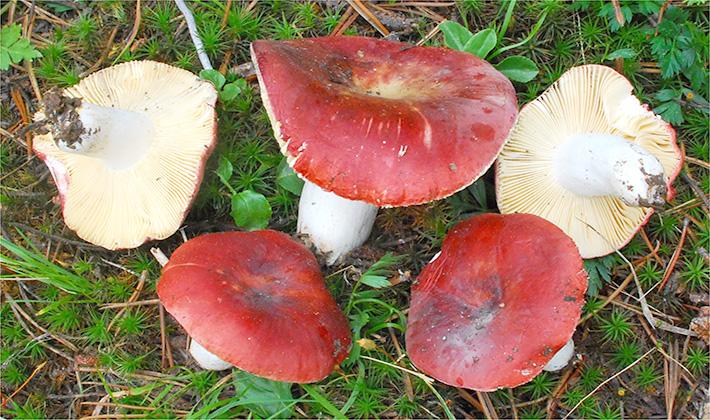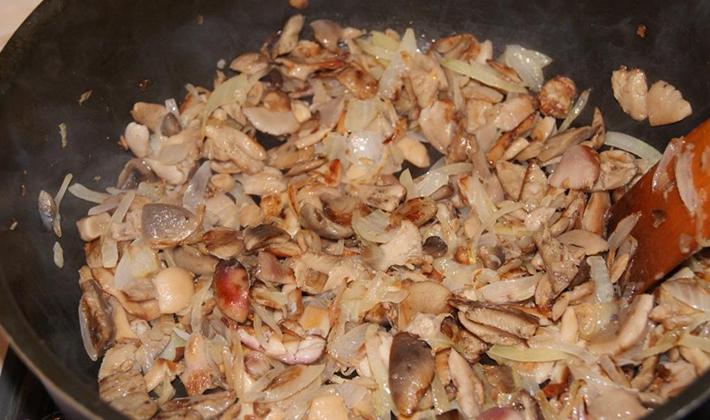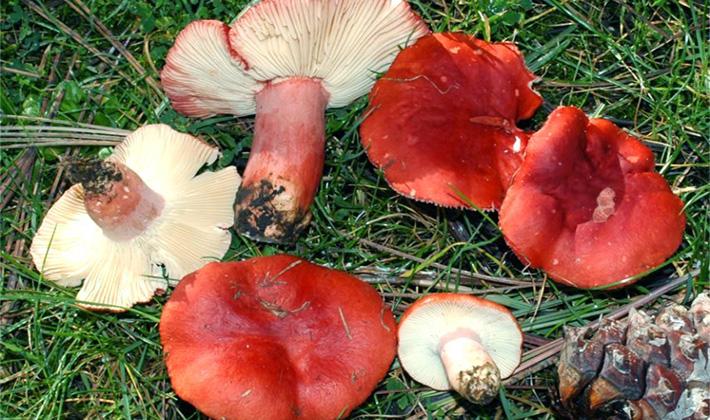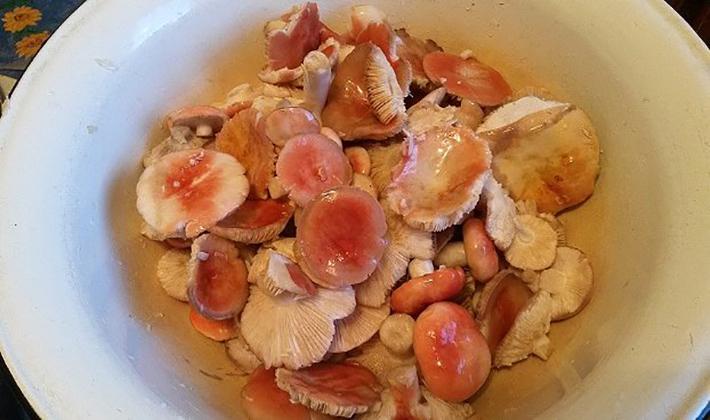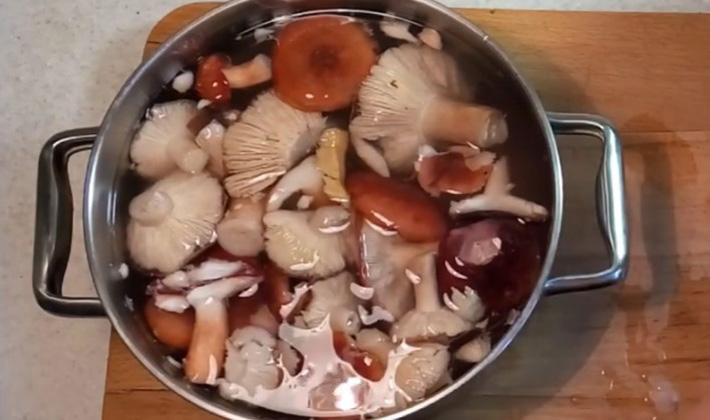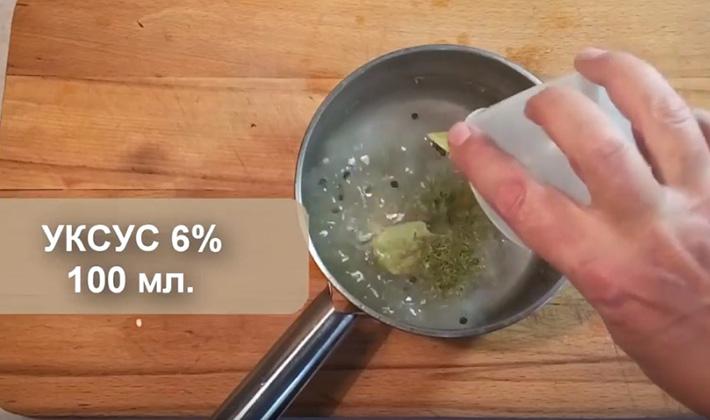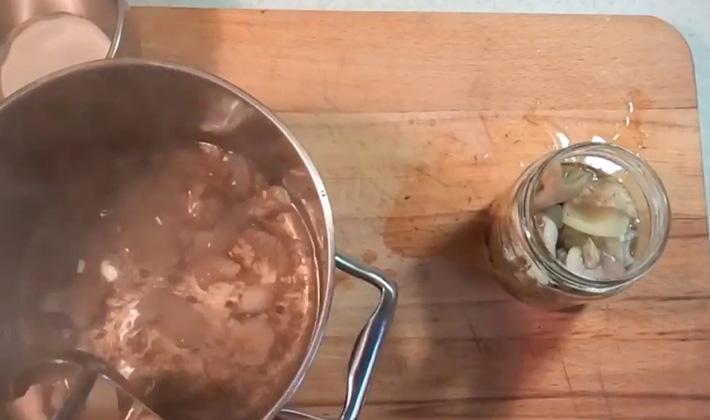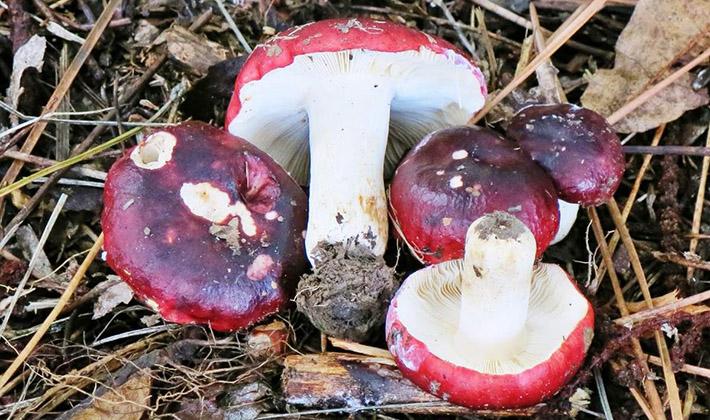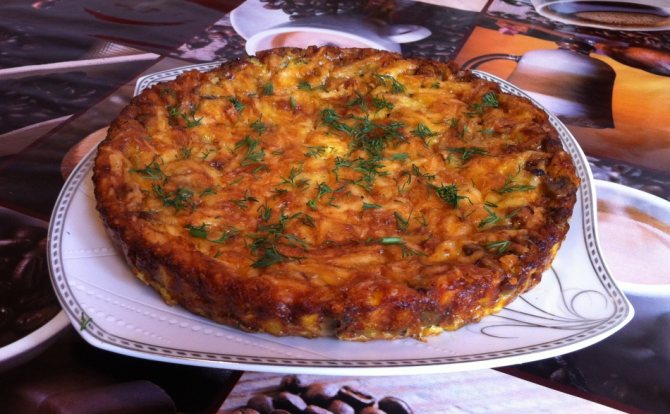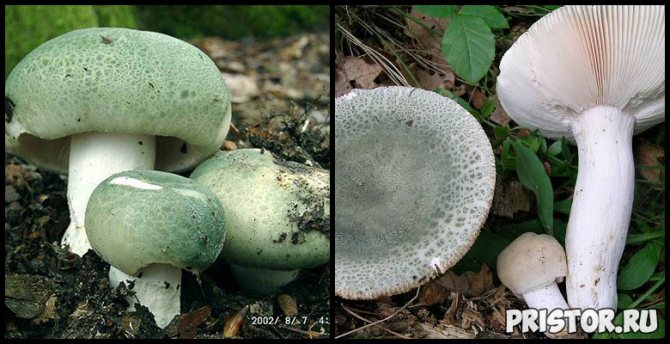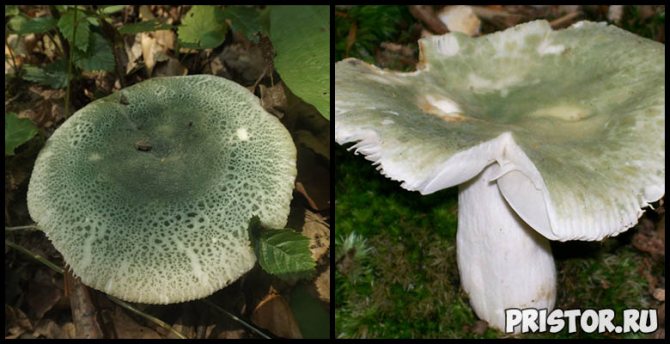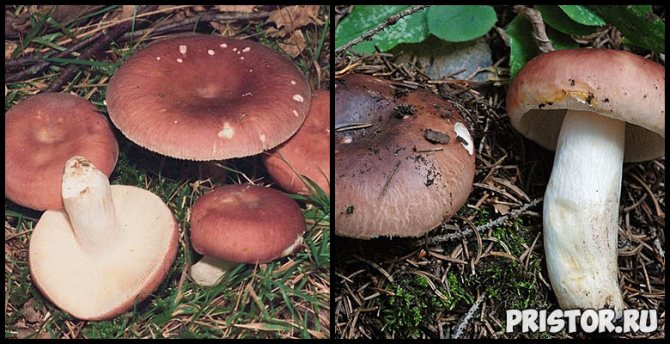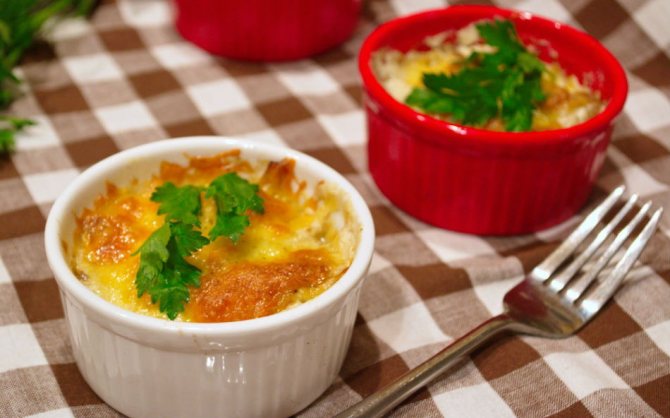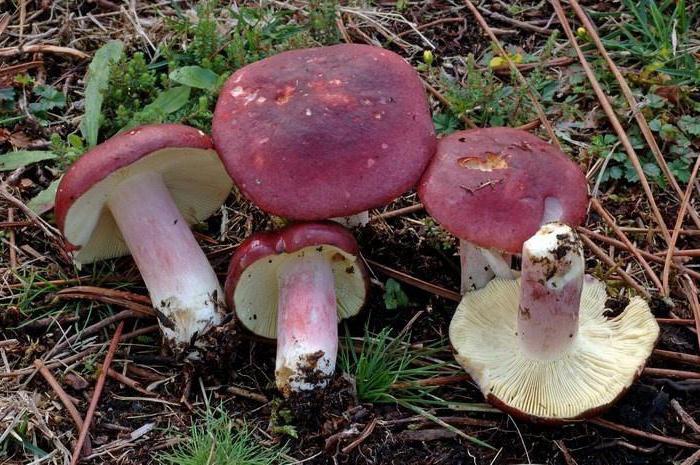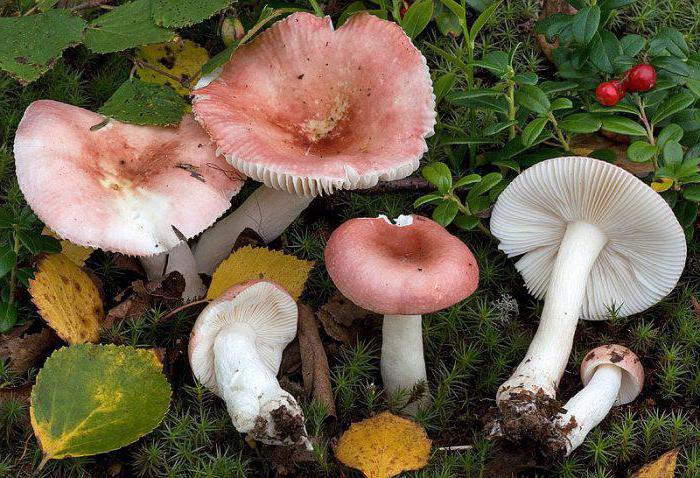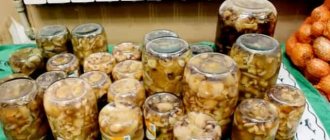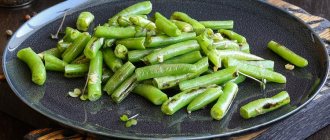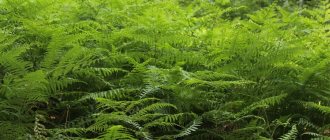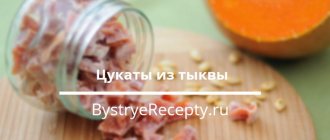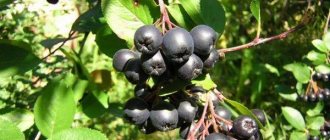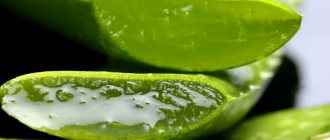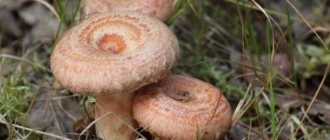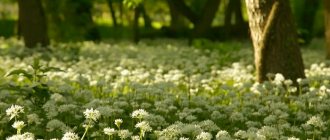Russula is a genus of lamellar mushrooms of the family Russula. Today, 270 species are known, among which almost all are suitable for human consumption. The russula got its name due to its unique property - it cooks much faster than other mushrooms. It is a nutritious, low-calorie product (only 15 calories are concentrated in 100 grams), which instantly satiates, does not lead to obesity.
Russula is a large mushroom with a hat, the plates of which are white or yellowish in color. They should not be brown, black or red as this indicates an inedible look. Russula grow on the ground under bushes and trees.
Mushrooms are harvested from June to October. All types with a mild taste are suitable for food.
Fresh russula supply the body with vitamins B1, B2, C, E, PP, lecithin, the enzyme rasulin, potassium, calcium, magnesium, sodium, phosphorus, and iron.
The rich chemical composition determines the beneficial properties of the product: it normalizes the concentration of cholesterol in the blood, cleanses the body of toxins, toxins, prevents blood clotting, thrombus formation, and has antibacterial properties.
Preliminary processing
There are tons of options for making russula for your everyday menu. There are no less opportunities for winter harvesting. But no one will deny that before cooking, these brittle mushrooms should be carefully processed, namely:
- Mushrooms freshly brought from the forest or bought at the bazaar are poured with water for two hours;
- after that, they sort them out, getting rid of the spoiled and worm-infected specimens;
- remove a thin film from the hats, rinse again and lay out on a wire rack so that the water can drain.
Features of members of the russula family
Characteristics of russula and its distinctive features:
- curled or flat cap;
- wavy or slightly raised edges;
- smooth skin;
- the plates are spotty, with purple streaks or amber drops;
- the flesh is white, sometimes acquiring a light shade of the color that the cap has.
There are many russula in every forest. Many mushroom pickers believe that there are no representatives of this family that can cause serious poisoning. But this is not at all the case. It is always important to distinguish between edible and poisonous species. After all, even one dangerous mushroom in a pan can harm your health. Therefore, you need to know what russula mushrooms look like, which should not be touched.

There are many russula in every forest
Baked mushrooms
Ingredients:
- mushrooms - 300 g;
- one tomato;
- onions - one piece;
- garlic - two cloves;
- one carrot;
- soft cheese - 150 g;
- ham - 100 g;
- rice - one glass;
- crispy crackers with salt - five pieces;
- mayonnaise - two tablespoons;
- sunflower oil;
- greens;
- salt;
- spice.
Cooking method:


Films are removed from the mushrooms, the legs are cut off. Each hat is sprinkled with salt and spices.- Round grain rice is cooked.
- They wash vegetables. Grate onions finely, and carrots, on the contrary, coarsely. The garlic is passed through a press. Vegetables and ham are sautéed. The fried mass is mixed with rice, grated cheese, the remaining ingredients and salt are also added there.
- The finished mass is used to fill mushroom caps. Now they are greased with a little mayonnaise and sprinkled with a thin layer of cheese.
- After sprinkling a little oil on the caps, they are placed on a baking sheet. Preheat the oven to 200 degrees and place our dish there.
- Mushroom legs, tomatoes and ham are cut into small cubes. The cheese is grated using a medium grater. Crackers are made into coarse crumbs.
Baked russula is a delicious and satisfying delicacy that is most often served as a separate dish.
Popular edible species
- Food russula. The cap of the mushroom is fleshy, uneven in color, finely reticulate-wrinkled, reddish, white-pink. In the middle it is brownish, buffy. The diameter reaches 5 - 10 centimeters. The edges of the cap are slightly ribbed or smooth, the plates are frequent, of the same length, yellowish-white, branched at the stem. Fruiting in July-October. Similarly, the mushroom can be confused with herring russula, the latter, in turn, has a pronounced fishy smell.
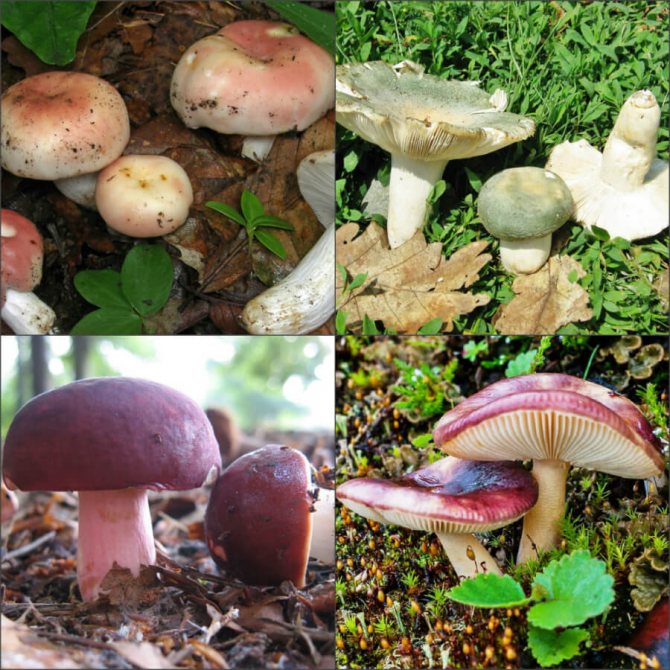

In folk medicine it is used as a diuretic, in cooking for pickling, salting, making soups.
- Russula are greenish (scaly). This is the most delicious type of mushroom among all the existing ones. All kinds of blanks are made of them, subjected to all types of culinary processing, with the exception of drying. The hat of the scaly russula is green, sometimes with a bluish tinge, fleshy, with a tightly adherent skin. Its surface is thick, dry, rough, warty, cracking with age, reaching 5 - 12 centimeters in diameter. The plates are white, sometimes with a yellowish tint. The pulp is dense, fragile, emits a pleasant mushroom smell. The leg is white, furrowed, becomes brown with age. At the break, the russula changes color, becomes a rusty color. The fruiting period is July - October.
According to the conclusion of Chinese biochemists, R. Virescens extract has a beneficial effect on the regulation of blood lipids. With regular use of the mushroom for 30 days, there is a decrease in triglycerides, total cholesterol. In addition, the level of serum, hepatic malondialdehydes decreases, the content of the enzyme superoxide dismutase increases.
The main useful property of this species of russula is the ability to suppress Ehrlich's carcinoma and Sarakoma-180 by 90%.
- Brown russula. The cap of the mushroom is dark red, brown-ocher, yellowish, olive, burgundy with a purple-brown or black center, strongly convex. Reaches 5 - 15 centimeters in diameter. Sometimes with a purple edge wrapped inward. The plates are soft, branched at the stem of a cream, ocher or brown color, turn brown when pressed. When broken, the flesh is white, after a while it darkens, the leg has a herring smell, which intensifies towards the base, the cap has a crab or nutty taste. The leg is white, rarely with rusty blotches, it can be pink or red.
Brown russula is characterized by a rich amino acid and protein composition. The extract from fresh fruit bodies inhibits the growth of the pyrimethamine-resistant malaria parasite, Plasmodium falciparum.
- The russula is blue-yellow. A distinctive feature is a variety of colors, which can be multi-colored, blurred. The color of the cap varies from purple, blue to dark green, red-brown, the diameter reaches 15 centimeters. The surface of the mushroom is sticky, shiny, with a ribbed edge. The pulp and stem are white, the plates are flexible, completely unbreakable. Fruiting from June to October.
Polysaccharides of the fruit bodies of the fungus have antitumor, antioxidant activity.
- Olive russula (herring). The cap is convex, outstretched, 5 - 12 centimeters in diameter, naked, slightly mucous, depressed in the center, with a ribbed edge. The pulp is white, turns brown with age. The peel is easily detached from the cap. Olive russula gives off a characteristic herring smell, which is especially felt in aging mushrooms at the base of the stem. The plates are frequent, adherent to the stem, white.With age, they become creamy, with pressure they turn brown. The leg thickness is 2 centimeters, the height is up to 10 centimeters, the surface is smooth, dirty pinkish yellow or white.
Fruiting in July-August.
Used for salting, pickling, soups, frying.
Cooking in batter
Ingredients:
- mushrooms - 300 g;
- sunflower oil;
- two chicken eggs;
- wheat flour - 4 tablespoons;
- salt;
- a glass of unsweetened soda.
Step-by-step cooking procedure:
- Peel mushrooms, rinse, cut into small cubes.
- Now they start making batter. You need to beat eggs and flour, slowly pouring water into it. Salt. Achieve the consistency that low-fat sour cream has.
- The frying pan is carefully greased with vegetable oil, heated over high heat.
- Mushrooms are rolled in batter and spread on the fry. Fry first on one side, then on the other until golden brown.
- To get rid of excess fat, the finished meal is placed on paper napkins.
The russula cooked in batter has a richer taste, moreover, the crispy crust makes the dish especially spicy. It goes well with various sauces.
Russula soup
Rich soup made from these mushrooms will impress even the most fastidious gourmet. And those who are tired of the usual menu will surely like such a dish.
Structure:
- mushrooms - 500 g;
- potatoes - 5 pieces;
- water - 2.5 l;
- onions - 2 pieces;
- red pepper - 2 pieces;
- carrots - one piece;
- garlic - 2 cloves;
- sour cream - 3 tablespoons;
- bay leaf - 2 pieces;
- greens, salt, spices - at your discretion.
Preparation:
- Peeled and washed potatoes should be cut into strips and placed in a saucepan of boiling water.
- The russula are washed, cut into cubes and, after frying for 10 minutes, mixed with chopped onions. Stew for five minutes.
- Potatoes, without being cooked, are mixed with mushrooms, onions, carrots and peppers.
- The mixture should be cooked for about 20 minutes, after which spices and salt are added to the soup.
- Cook until fully cooked, then poured into separate plates and served to the table, decorated with a sprig of parsley or dill.
Those who do not want to bother standing in front of the stove can try making such a soup in a slow cooker.
Cold salting
How to cold salt russula at home? Pickles lovers should focus their attention on this recipe, because thanks to it you can prepare a great appetizer for the festive table.
You will need:
Take a clean frying pan in which grated carrots and chopped bell peppers are fried. All are fried for 3-5 minutes.
- mushrooms - 1 kg;
- water - 0.25 ml;
- salt - 100 g;
- two bunches of dill;
- three cloves of garlic;
- two leaves of black currant.
A delicacy is prepared as follows:
- First you need to soak the mushrooms (two days are enough). At the same time, do not forget to change the water twice a day.
- The mushrooms are placed in a container with salted water for about 6 hours.
- Currant leaves are placed at the bottom of the pan, and then russula, sprinkled with salt, chopped garlic and spices.
- The mushroom mass is poured into a glass of water and pressed with some heavy object. After two weeks, the pickles will be ready to eat.
Edible russula mushrooms: benefits and harms, what can be confused with?
Before talking about the benefits and dangers of these mushrooms, it must be said that there are 2 types of russula, which can easily be confused with a really dangerous mushroom - pale toadstool.
- So, a green and greenish russula can be confused by inexperience with a pale toadstool, the use of which can end in the death of a person.
- Remember, there are no films, wraps, etc. on the leg of the russula. Pale toadstool at the bottom of the leg has a kind of wrapper.
- On top of the toadstool's legs, you can also most often see a "skirt" made of film, the russula's leg is "clean", without films, etc.
- In the russula, the leg is straight and even, without thickening, in the poisonous mushroom, the leg is thinner to the top.
- Also pay attention to whether the mushroom "loves" worms, bugs, etc. As you understand, none of the representatives of the animal world will eat a poisonous mushroom. Therefore, if the mushroom is not touched, it is very beautiful, think about whether it is edible.
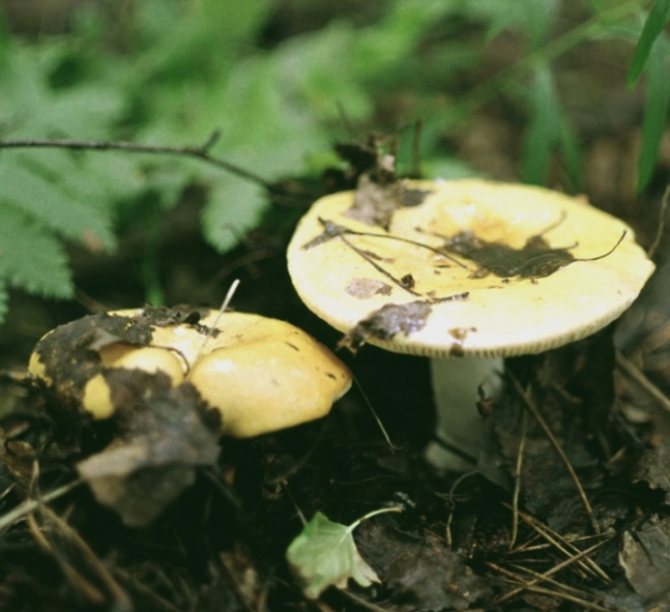

Russulas are both useful and harmful
Relatively russula benefits the following must be said:
- These mushrooms, like many others, are a source of vitamins and minerals. For example, russules contain a sufficient amount of B vitamins.
- Also, these mushrooms contain fatty acids.
- Moreover, russula contains an enzyme called russulin, which promotes milk clotting. This substance is essential in cheese making.
As for the possible harm from these mushrooms, we can say the following:
- The greatest harm can be caused not by russula, but by poisonous mushrooms, with which they can be easily confused. In this case, even lethal consequences are possible.
- Also, some types of russules can provoke mild poisoning and, accordingly, vomiting, nausea, etc.
- In large quantities, these mushrooms give a rather serious load on the stomach and heart, so you need to eat them a little.
Pickled russula
Perhaps it will not be an exaggeration to say that this is one of the most delicious and at the same time easy to prepare preparations for the winter.
so, to prepare the product you will need:
- mushrooms - 2 kg;
- black pepper - 7-8 peas;
- 5% vinegar - 200 ml;
- table salt - 1.5 tablespoons;
- granulated sugar - two teaspoons;
- bay leaf - 3 pieces;
- water - 0.75 l;
- dried clove buds - 5 pieces.
The sequence of actions when marinating russula:
- First of all, you need to clean and rinse the main ingredient, and then fill it with water so that it covers the mushrooms by no more than 2 cm.
- A saucepan with mushrooms is placed on low heat. Cook them for 10 minutes, constantly skimming off the foam.
- Now you need to prepare the marinade itself. To do this, mix salt, sugar and existing spices.
- After boiling the mixture for about five minutes, add apple cider vinegar to it.
- Using a slotted spoon, the mushrooms are removed from the water and instantly placed in the prepared marinade.
- Further, after boiling for 10-15 minutes, the mushrooms are sorted into jars, before that, remembering to sterilize the dishes and lids.
- Having rolled up, the banks are wrapped in a fur coat or woolen sweater, waiting for them to cool.
- The workpieces are stored in a cool place - in a cellar or on a refrigerator shelf.
Selection and storage


If you are not a mushroom picker, russula can be bought in the market from people who know a lot about them. The most important thing is to choose the right product. Examine the mushroom carefully. A real russula has a dense or hollow stem, smooth, white. The pulp is extremely fragile, it may darken on cut (extremely rare). There are no membranes. A hat of various colors with white or yellow plates. But in no case can they be brown, black or red. If there is a purple or purple spot on the cap, it is most likely a false, inedible russula.
In the selection process, give preference to dense mushrooms, avoid old, dry specimens. The best quality and tastiest are blue-green or yellow russula.
After harvest, the crop retains its nutritional properties for the next 24 to 48 hours. It is believed that the mushroom is a perishable food that should be cooked right away. If the preparation of the dish is planned for the next day, then dry russula is placed in the refrigerator.
Dried mushrooms can be stored for up to 1.5 years. And salted and pickled no more than 1 year. Interestingly, after drying, forest bread retains useful amino acids and dietary fiber, only protein, which makes up 40% of the original amount, is removed.
Mushroom caviar
Using the following recipe, you can make delicious caviar from this variety of mushrooms. Such a snack can be safely stored in the refrigerator for a long time and prepared for the winter. To improve the taste, you can add garlic and fresh tomatoes to the treat.
Ingredients:
- main product - 500 g;
- two onions;
- two small carrots;
- sunflower oil - 100 ml;
- 5% apple cider vinegar - 20 ml;
- bay leaf - 1 piece;
- fresh herbs, pepper, salt - to taste.
Preparation:
- Mushrooms are prepared for cooking. Salt the water. Boil russula until they sink to the bottom of the container.
- Using a slotted spoon, remove the contents of the pan.
- Mushrooms are chopped in a blender or in a meat grinder, mixing them with chopped onions and fried carrots.
- The resulting mass is transferred to a clean saucepan. Vegetable oil and vinegar are poured there. Spices and salt are added.
- Now the mushroom caviar is stewed. This stage will take at least an hour.
- The finished product is packaged in sterile jars and stored in the refrigerator.
Freeze the gifts of the forest
It often happens (especially in fruitful years) that the mushrooms literally have nowhere to go. All dishes with them have been tried, and all the cans are twisted. Then it's time to remember about freezing. The product can be stored frozen for more than a year, while using it to prepare your favorite dishes.
Recommendations for freezing mushrooms:
- Before sending the mushrooms to the freezer, they are prepared: they are sorted out, cleaned of dirt, grass and leaves, washed.
- In addition, it is advisable to soak and boil this variety of mushrooms before freezing. They can be fried if desired.
- After boiling, it is advisable to dry the mushrooms and then pack them in airtight bags.
- The mushroom mass is stored in the freezer.
Russula are tasty, healthy and nutritious mushrooms that novice mushroom pickers mistakenly confuse with toadstools. These common mushrooms, like no others, are suitable for preparing all kinds of dishes. Any housewife who has mastered the process of preparing russula will confirm that such mushrooms can become a decoration of the table, and in the stomach they are digested faster than other types of edible mushrooms.
Published 03/16/2018 by samsonmain and posted under Edible. Bookmark the permalink.
Mushroom julienne recipe with chicken in buns
Description of hygrophoric mushrooms: edible late and early varieties
Botanical description
Russula - cap mushrooms growing on a straight stem, without tubers and rings. In young representatives, the apex is hemispherical, which straightens with age, becomes flat, reaching 10 centimeters in diameter. The russula are ubiquitous: in a rare birch forest, in a pine and deciduous forest, on the side of the road, on a mossy bank, on the edge. The best period for collecting forest beauty is August-September.
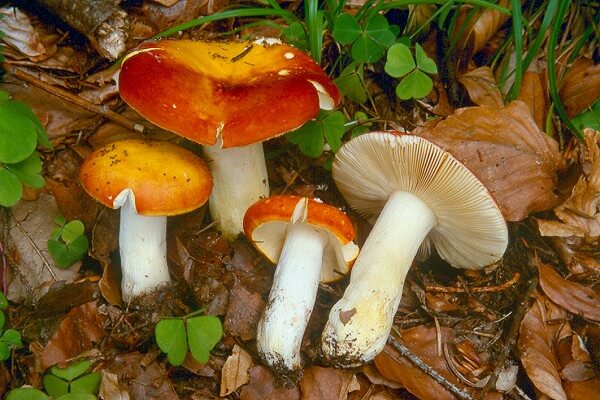

Description:
- Hat. Initially it has a bell-shaped, hemispherical, spherical configuration, later it becomes funnel-shaped, flat or prostrate, less often - convex. The edge of the cap is striped or ribbed, curled or straight. The skin is of various colors, shiny or dull, dry, less often moist, adherent, easily separating from the pulp, sometimes cracking.
- Plates. Descending or free, adherent, notched, of equal or unequal length, frequent, sometimes sparse, forked-branched. The color of the plates is white, yellowish, the edges are obtuse, pointed, depending on the species.
- Leg. White or colored, cylindrical, even, rarely pointed, thickened at the base, dense or hollow inside.
- Pulp. White, does not change color with age and on the cut, spongy, fragile, dense in the stem, with a mild subtle taste. Burning, pungent notes indicate that the mushroom is poisonous and unsuitable for human consumption.
- Spore powder. The color ranges from white to dark yellow.
Russula - edible in 90% of cases, some have a bitter taste, which, as a rule, disappears after heat treatment and soaking.
It is not recommended to eat mushrooms raw, as they irritate the mucous membranes of the digestive system, can lead to vomiting, poisoning and intoxication of the body.


